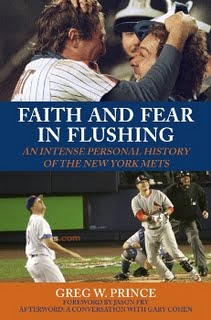On a recent evening, Rosemarie and I were strolling around our Seattle neighborhood. A gent who’d gotten in his cups a little early stopped before us, turned to Rosemarie, and said, “What’s a good-looking woman like you doing with a Mets fan?”
(I was wearing a Mets cap. As is my wont.)
Rosemarie replied, “This man is my loving husband of almost twenty years. And I’m also a Mets fan.” Appropriately chastened, the interloper took his leave.
We walked on. “So, uh, thanks for sticking up for me,” I finally said.
“Forget it,” Rosemarie replied. “He did say I was good-looking, right?”
Random abuse is part of being a Mets fan. I don’t know how it works between Cubs and White Sox partisans, but in New York you always have to explain why you root for the orange and blue. That’s because the Yankees are the Yankees, and the Mets are the Mets.
But root for them I do. The Mets have been a part of my life for as long as I can remember. Before movies, before crime fiction, there was the Mets. Blame growing up in Queens, just a stone’s throw from Shea Stadium. They were my home team in every sense. (Rosemarie, a product of Flushing, would actually walk to games.) Being a Mets fan is an inextricable part of my identity. Ask anybody who knows me.
 Greg Prince is one of the writers behind Faith and Fear in Flushing, a regular stop for me. He’s spun the blog into a book. Subtitled An Intense Personal History of the New York Mets, that’s exactly what it is: a look at how supporting a team, through good times and bad, becomes a constant, a way of marking the years. It’s about the twinned joy of giving yourself over to something larger, and the agony of being at the mercy of that which you can’t control. Substitute the names and it could be about your team. But if the phrase Grand Slam Single produces chills in you as it does in me, you’ll love it.
Greg Prince is one of the writers behind Faith and Fear in Flushing, a regular stop for me. He’s spun the blog into a book. Subtitled An Intense Personal History of the New York Mets, that’s exactly what it is: a look at how supporting a team, through good times and bad, becomes a constant, a way of marking the years. It’s about the twinned joy of giving yourself over to something larger, and the agony of being at the mercy of that which you can’t control. Substitute the names and it could be about your team. But if the phrase Grand Slam Single produces chills in you as it does in me, you’ll love it.
So as Opening Day dawns on Monday, I will once again don my cap in support of the most dysfunctional team in professional sports. This in spite of the fact that they’re in a division with the Phillies, the National League equivalent of the Yankees and Red Sox: a perennial contender. That everyone expects them to flirt with .500 and place no better than third this season. That sportswriters have taken to calling for regime change as if the front office is part of the Axis of Evil, or comparing Citi Field to the hell of Dante’s Inferno.
Instead, I’ll focus on the good times. Cementing my bond with my friend Mike, whose blog Metsanity is well worth reading. The 1986 world championship; game six remains one of the high points of my life. Meeting Tom Seaver, the man to this day known as The Franchise. Want to see hero worship? Look at my face.
Or simply helping out another fan. It’s late 2007. Only a few weeks after the Mets’ storied collapse, blowing a seven-game lead with seventeen to play and missing the playoffs entirely.
Whoo. Hang on. I need a minute.
I have to run to the grocery store. It’s raining, so without thinking I put on my Mets inclement weather cap – yes, I have more than one – and head out. I’m in the express line when the guy behind me taps me on the shoulder.
“I have to tell you, I’m so glad to see you,” he says to me in a quiet voice. “I haven’t been able to put on my cap since it happened.”
“You’ve got to man up,” I told him. “Next year starts right now.”
I am way, way too proud of that moment.








